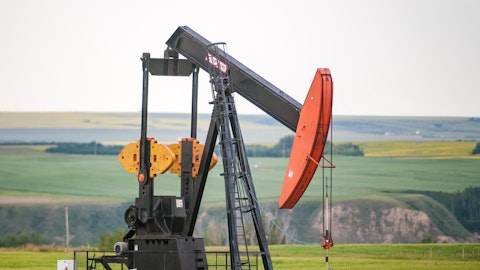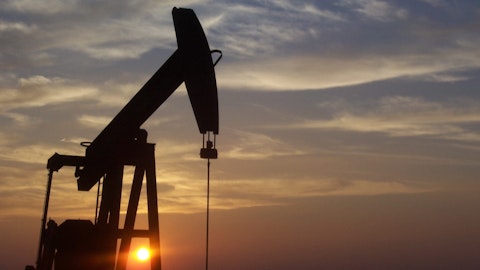Texas Pacific Land Corporation (NYSE:TPL) Q4 2022 Earnings Call Transcript February 23, 2023
Operator: Good morning, and welcome to Texas Pacific Land Corporation’s Fourth Quarter and Full Year 2022 Earnings Conference Call. This conference call is being recorded. I would now like to introduce your host for today’s call, Shawn Amini, Vice President, Finance and Investor Relations. Please go ahead.
Shawn Amini: Thank you for joining us today for Texas Pacific Land Corporation’s fourth quarter and full year 2022 earnings conference call. Yesterday afternoon, the company released its financial results and filed its Form 10-Q with the Securities and Exchange Commission, which is available on the Investors section of the company’s website at www.texapacific.com. As a reminder, remarks made on today’s conference call may include forward-looking statements. Forward-looking statements are subject to risks and uncertainties that may cause actual results to differ materially from those discussed today. We do not undertake any obligation to update our forward-looking statements in light of new information or future events. For a more detailed discussion of the factors that may affect the company’s results, please refer to our earnings release for this quarter and to our most recent SEC filings.
During this call, we will also be discussing certain non-GAAP financial measures. More information and reconciliations about these non-GAAP financial measures are contained in our earnings release and SEC filings. Please also note, we may at times refer to our company by its stock ticker, TPL. This morning’s conference call is hosted by TPL’s Chief Executive Officer, Ty Glover; and Chief Financial Officer, Chris Steddum. Management will make some prepared comments, after which, we will open the call for questions. Now, I will turn the call over to Ty.
Ty Glover: Good morning, everyone, and thank you for joining us today. 2022 was a consecutive record year for TPL. Full year 2022 revenue of $667 million exceeded the previous record by over $170 million. We not only generated record revenues from our oil and gas royalties, but our combined water sales, produced water royalties and easements and service-related income also had its best year ever, generating over $200 million of revenue. We achieved a full year consolidated adjusted EBITDA margin of 89% as we continue to efficiently convert revenue into cash flow. We returned $335 million of capital back to shareholders through dividends and buybacks, and we exited the year with zero debt and over $500 million of cash on the balance sheet.
The company also made progress towards expanding our revenue opportunities beyond our legacy business. In 2022, we increased our contracted renewable production on our surface by 37% year-over-year. We signed agreements for the potential development of carbon capture, battery storage and bitcoin mining facilities, and we continue to have a lot of good discussions on other interesting fronts. On the topic of carbon capture, we were glad to strike an agreement last month with Ozona. We’ve been impressed with Ozona’s expertise and initiatives, and it’s encouraging to see these projects move closer towards reality. Our goal at TPL is to help lay the groundwork as the carbon capture industry scales up and position ourselves to be a key part of the solution and value chain.
Another opportunity that we’ve been working to exploit is sand deposits located on our acreage. We recently executed four separate contracts on in-basin wet sand mines. This reflects years of effort by the team here in conducting geologic studies to identify sand deposits, to assess the feasibility of utilizing wet sand for well completion and to proactively initiate discussions with operators and customers to underwrite development. These potential projects would generate direct revenue benefit to TPL. They would also deliver the dual benefit of sourcing a critical input used in the development of TPL royalty acreage, while also significantly reducing truck congestion and associated emissions compared to using sand sourced and transported from out of basin.
Yesterday, we announced an agreement with bpx, a subsidiary of BP, to provide comprehensive source water, produced water offtake and surface access across approximately 270,000 acres spanning Culberson, Loving and Reeves Counties. This agreement will facilitate bpx’s oil and gas development of a high-quality resourcebase in the Delaware Basin, while providing TPL incremental value across multiple water and surface revenue streams. We have known and worked with the BP team for a long time, and we’re very excited to see them ramp Permian development. I also want to spend some time today discussing some broader Permian topics pertinent to TPL. First is the potential trend of declining well productivity. TPL of course doesn’t operate owned gas wells, so we don’t have the detailed perspective that our operators do, but we do monitor what’s going on in our backyard.

Photo by All Bong on Unsplash
What we’ve observed is that operators continue to experiment with optimal development strategy, especially for acreage prospected for multiple zones. Trend seems to be that an increasing number of operators are moving towards co-development of multiple zones within a section, as opposed to drilling one zone first and then returning at a later time to develop the other zones. We’d note that, a large portion of our operators have been deploying the former co-development strategy for quite some time, resulting thus far in consistently robust well productivity. In addition, laterals on our acreage continue to trend longer. Fourth quarter 2022 was the first quarter where new permitted wells, new spuds, new completions and new producing wells each averaged over 10,000 feet.
Overall, we continue to see strong well performance and productivity across our acreage. One other industry focal point is the increasing price differential between local Permian natural gas and coastal markets. As many are aware, natural gas pipeline capacity out of the Permian remains tight. Some relief will come this year, with a couple of pipeline capacity expansions and repairs. That said, we have started to see natural gas pricing realizations weaken, especially among smaller independent and private producers. Although, marginally weaker gas realizations will negatively impact our royalty revenue, it presents significant upside for TPL on the surface side. Insufficient takeaway capacity means that the industry has an incentive to develop additional new midstream infrastructure.
And given our vast checker-boarded surface footprint, this presents pipeline easement opportunities for TPL to pursue. Any revenue that we lose from weaker gas differentials, we could potentially more than offset with incremental easements. This is another example of the benefit of our active management approach and the natural hedges that we’ve built into the business here. Another item, we are watching closely is the evolving practice of handling produced water, especially in response to the previous seismic response areas, otherwise referred to as SRAs. As a reminder, these SRAs were enacted by the State Railroad Commission in response to previous seismic activity. Among the biggest impact of the SRAs was the reduction of injection rates into deep-formation saltwater disposal wells otherwise referred to as SWDs. As a result, deep-formation SWDs have generally experienced much lower utilization, and we’ve concurrently seen a large increase in demand for shallow-formation SWD permits on our surface.
Going back to the inception of our water business, we’ve been very deliberate in limiting the amount of deep SWD permitting on TPL. This helps to preserve viability of third-party infrastructure operating on our surface, while also keeping with our focus on sustainability and safety. Just to reiterate TPL does not own or operate SWDs. Rather, we have negotiated with various operators a type of surface use agreement that pays TPL royalty for any produced water barrels that are either stored directly on or that cross TPL’s surface. These agreements in aggregate cover acreage spanning approximately 0.5 million acres in West Texas. Contracts also contain strong indemnification language protecting TPL interest as operator and water midstream companies continue to build and develop infrastructure on our surface.
It’s not an accident, how we set up the water business here at TPL, and this all serves as a testament to our water team for their skill and foresight. Looking forward to 2023, although we do not control the direction of commodity prices which directly impacts a large portion of our revenues the TPL team remains committed to sustaining our positive momentum. Our assets are positioned in the heart of one of the best resource plays found anywhere in the world, and should development slow down in response to lower commodity prices or other constraints the immense resource still remains in the ground and available to be exploited in the future when commodity prices strengthen. Finally, I want to thank all the employees here at TPL for their diligent work and commitment.
In 2022, we had zero spills, zero reportable safety incidents, reduced our Scope one emissions by 34%. So not only did our employees help the company achieve record revenues, industry-leading consolidated adjusted EBITDA margins and record earnings and free cash flow per share, but they did it safely efficiently and with a stakeholder mentality. With that, I’ll turn the call over to Chris to discuss our financial results.
Chris Steddum: Thanks, Ty. The total revenue for fiscal year 2022 was $667 million, a 48% year-over-year increase. Net income of $446 million during fiscal year 2022, was also a corporate record and this represents a 65% increase compared to prior year net income. The strong performance was driven not only by higher commodity prices and higher royalty production, but also year-over-year revenue increases of 25% for source water, 24% increase in produced water royalties, and 28% increase in easements and other surface-related income. Excluding ad valorem taxes, a new expense we started to accrue in 2022, our total consolidated operating expenses increased 9% year-over-year. The increase was mostly driven by an approximately $4 million increase, in water service-related expenses as a result of higher source water sales volumes.
Royalty production for the full year and for the fourth quarter of 2022, each came in at approximately 21,300 barrels of oil equivalent per day. On a sequential quarter-over-quarter basis, oil and gas royalty production declined by approximately 9%. On a year-over-year basis, royalty production grew by approximately 15%. As we regularly discussed in the past, quarterly oil and gas royalty production will normally have some embedded volatility related to the timing of when we receive our royalty revenue check stubs, versus when that production actually occurred in the field. To that end, let me provide some additional context on what we can expect for production going forward. Based on our internal data to date in 2022, we had new permits of 876 gross and 10.9 on a net basis.
For spuds in 2022, so far our tally show 835 gross and 10.3 net. We consider these to be very strong levels, not just for 2022, but also to support 2023 development activity. Data that occurred during the fourth quarter, tends to lag a few months for new completion and new producing wells. But if we look at third quarter 2022 data, which has been more fully reported we show new completions of 262 gross and 3.1 net and new producing wells of 208 gross and 2.7 net. Again, this represents very robust levels for the company and supports strong production levels. I mentioned earlier, current commodity prices across the board have declined from the elevated levels we saw for much of 2022, and natural gas takeaway is tight. We have seen this diminished price realizations most especially for smaller independents and privates that generally, don’t have as much committed pipe capacity.
Those factors among others could contribute to a moderated growth trajectory in the short term for the Permian, as a whole. At TPL, we do have a few things working in our favor. First, activity on our acreage is dominated by large integrated and large independent energy companies, which tend to have more contracted pipeline takeaway capacity and more resilient capital budgets, through periods of commodity price volatility. Second, our Northern Delaware royalty acreage, which has significantly higher net royalty interest, compared to our Midland royalty acreage, continues to receive a lot of attention from operators. Our land and water teams continue to be as busy as ever. And although, quarterly production figures can jump around somewhat quarter-to-quarter, we have strong conviction that TPL’s royalty production continues to trend upward.
In conclusion, last week we announced that our Board has approved increasing our quarterly dividend by $0.25 to $3.25 per share. For the fourth quarter of 2022, we repurchased approximately 12,000 shares for approximately $29 million. Starting in 2023, we now have an expanded $250 million share repurchase plan that replaces our previous $100 million repurchase plan. We intend to repurchase shares under this plan throughout the year, and the expanded size of this plan provides us the ability to accelerate share repurchases depending on factors such as commodity prices, market volatility and the relative attractiveness of special dividends and other value-enhancing options. Our high-margin capital-light and net cash position ensures the company will have substantial free cash flow, even during potential prolonged periods of depressed commodity prices and those unique virtues provide us with a lot of flexibility, and opportunity to actively allocate capital to enhance shareholder value, through virtually any commodity price environment.
With that, operator, we will now take questions.
See also 11 Most Profitable Chinese Stocks and 15 Most Profitable New Stocks Today.
Q&A Session
Follow Texas Pacific Land Trust (NYSE:TPL)
Follow Texas Pacific Land Trust (NYSE:TPL)
Operator: Thank you. Our first question is from Derrick Whitfield with Stifel. Please proceed
Derrick Whitfield: Good morning, all.
A €“ Ty Glover: Good morning, Derrick
A €“ Chris Steddum: Good morning, Derrick
Derrick Whitfield: Good morning. For my first question I wanted to focus on the growth outlook for your business segments. With the understanding, that you don’t provide quarterly guidance, how should we think about the near-term production trajectory in light of your line of sight activity and what appears to be a one-off quarter in Q4?
Chris Steddum: Yes. Thanks, Derrick. Like we said in the comments, any given quarter there is going to be some volatility. The timing under which some of these wells get completed and where rigs are related to our interest can certainly cause some volatility quarter-to-quarter. But I still think our general view is TPL can continue to outperform the Permian as a whole over the near to medium-term. And some of the things we also look at that encourage us that we’re still in a real strong position. When we exited 4Q 2022, when I look at our normalized DUC count, it’s basically as high as it’s ever been. And so to your point when we think about near-term inventory, that DUC count is really that near-term inventory we have available to draw from and where most of our production for the coming year is going to come from.
And so the fact that we’ve got a really nice set of normalized net DUCs gives me a lot of encouragement about the production that will be coming here in the near-term for us.
Ty Glover: Derrick, I would just add. One of the main things that gives us that comfort that Chris was talking about are these broad development agreements like we announced yesterday that we put in place with bpx. We’ve talked about these agreements in the past that cover these large AMIs. So if you look at that one that’s a multifaceted agreement that covers surface use source water sales, produced water off-take, recycling treatment. So getting an agreement in place with a major operator like bpx that covers that much acreage. Now we’ve got most of our acreage in the Delaware with most of our major operators covered with a development agreement similar to this. And so that really gives the operator like bpx the certainty that they need for their operations so that they can ramp up development across their leasehold and it also makes sure that TPL is involved in the entire value chain produced from that development.
So we’re really excited about that. We think it’s going to create a lot of value for both companies. Something that we’ve been working on for a long time and I’m really excited to see it finally come together.
Derrick Whitfield: That’s great. Maybe Ty just to clarify too on the bpx announcement. Does that add third-party services across your footprint? Meaning new acreage dedications that you wouldn’t have had otherwise, or really simply just facilitate bpx’s ability to grow by streamlining the processes.
Ty Glover: Yes. I think it’s a bit of both. So it adds to the ongoing relationship that we’ve had with bpx and then just opening up more acreage for them setting out terms of development ahead of time so that they can move faster.




